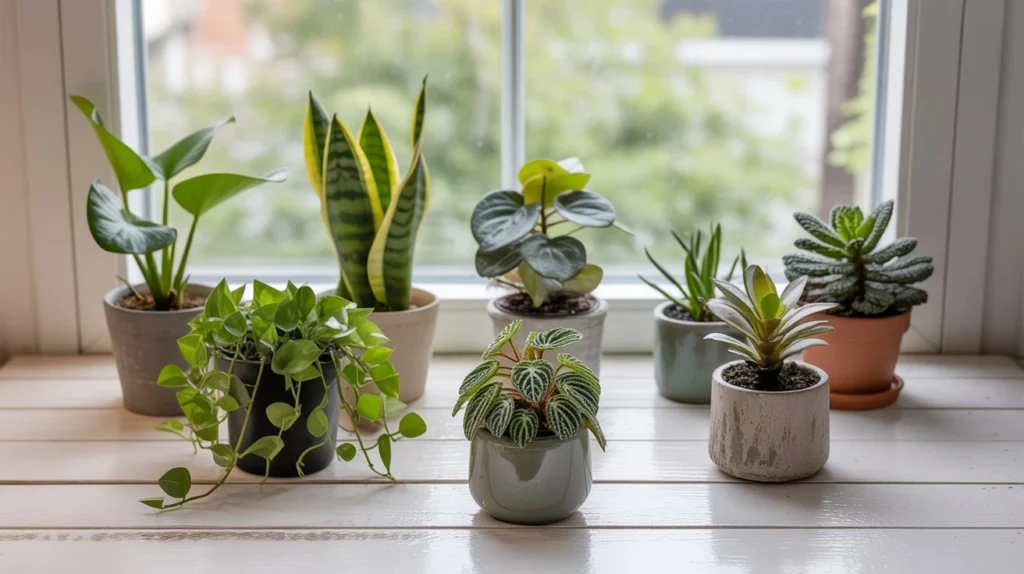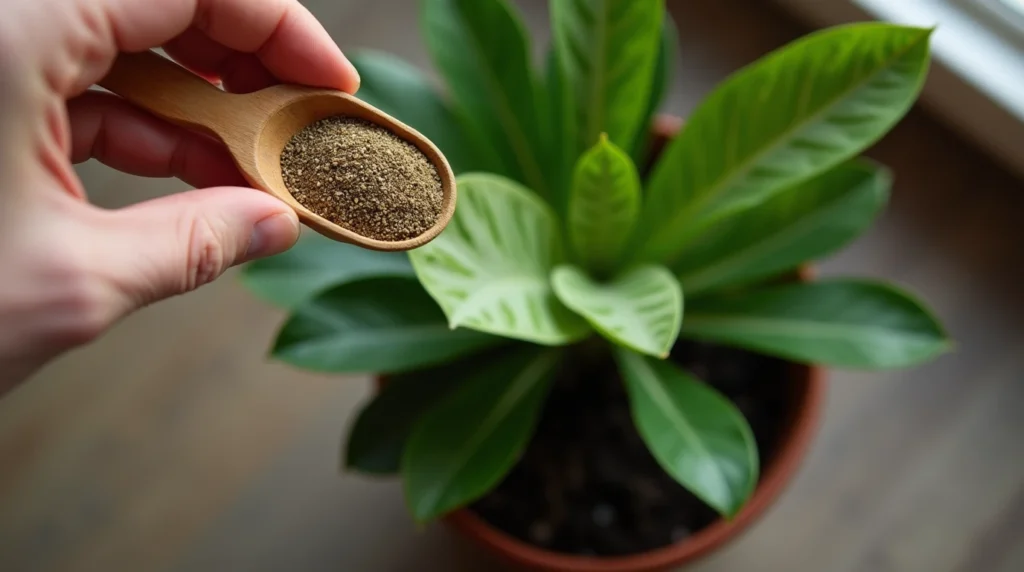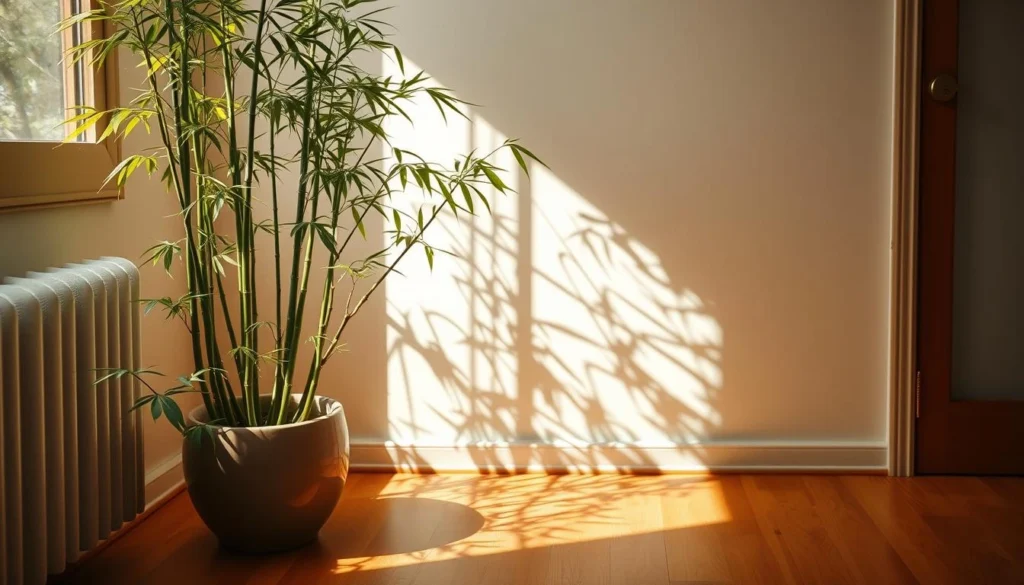
Did you know an indoor bamboo plant can make you feel better and clean the air? With the right care, these plants can grow well in your home. They add a natural beauty to any room.
Taking care of your bamboo is simple. Just follow a few easy tips to make your plant healthy. This guide will teach you the basics of caring for your indoor bamboo. You’ll learn how to make your natural decor shine.
By the end of this article, you’ll know how to keep your bamboo happy. Let’s start making your indoor space greener and happier!
Understanding Different Types of Indoor Bamboo Plants
Indoor bamboo plants are not just pretty; they also come in many types with different needs. When picking a bamboo for your home, knowing the various species and their needs is key.
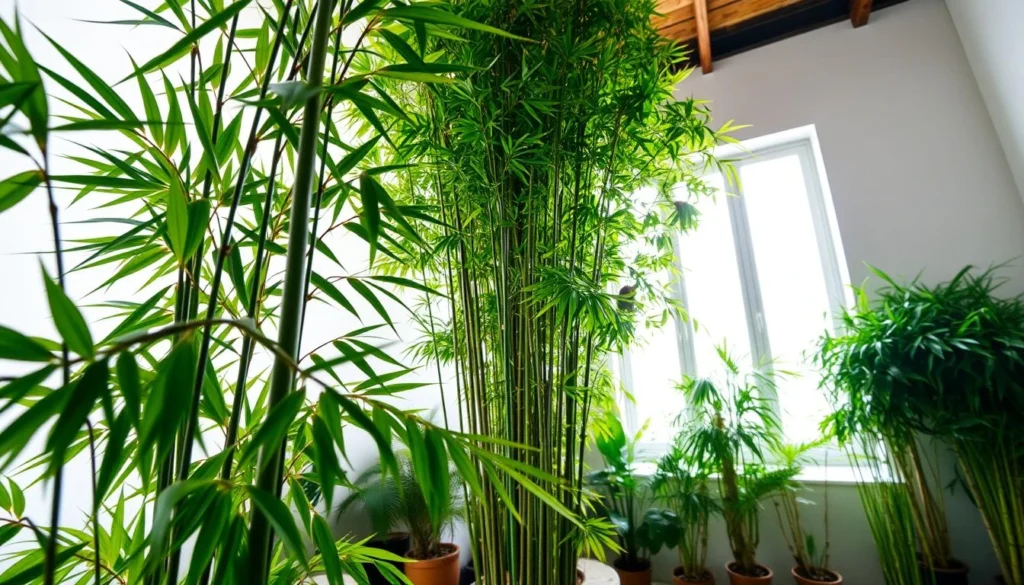
Lucky Bamboo vs. True Bamboo Species
Lucky bamboo (Dracaena sanderiana) is often confused with true bamboo. It’s a favorite for indoor plants because it’s easy to care for and can handle low light. But, it’s actually from a different family than true bamboo.
True bamboo, like Phyllostachys and Bambusa, is part of the Poaceae family. They are bigger and need more specific care than Lucky bamboo. This makes true bamboo harder to grow indoors.
The big difference between Lucky bamboo and true bamboo is how they grow and what they need. Lucky bamboo is easier to care for indoors, making it a best indoor bamboo plant for beginners.
Best Bamboo Varieties for Indoor Growing
Some top picks for indoor bamboo include Bambusa tulda and Dendrocalamus giganteus. But for most homes, smaller varieties like Bambusa ventricosa and Chimonobambusa are better. They are smaller and easier to manage.
When picking a bamboo house plant, think about the light, temperature, and humidity in your home. This will help you choose a variety that will do well indoors.
Essential Care for Your Indoor Bamboo Plant
Knowing how to care for your indoor bamboo plant is important. It ensures your plant stays healthy and beautiful. This makes your indoor space better.
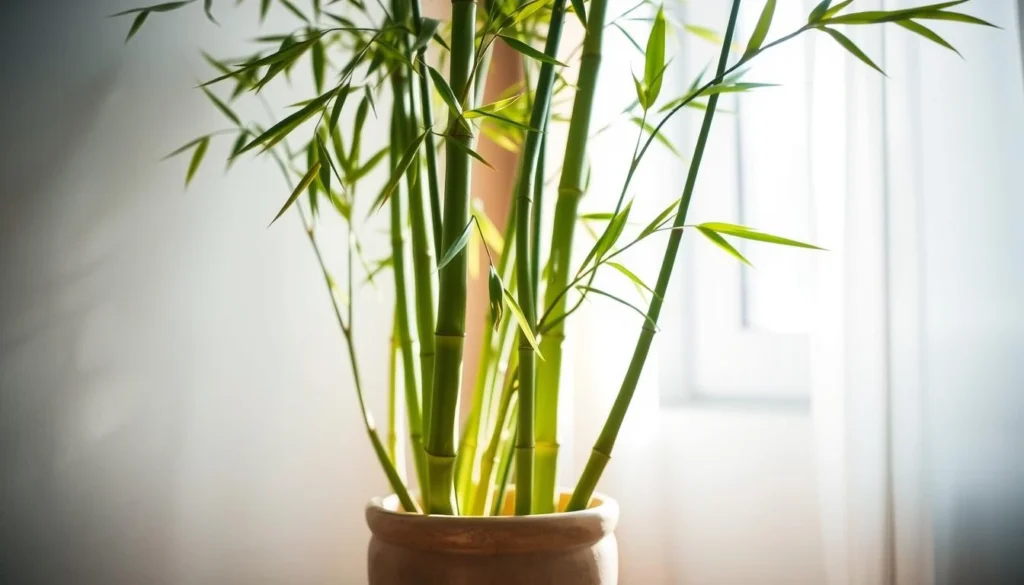
Light Requirements and Ideal Placement
Indoor bamboo plants like bright, indirect light. Direct sunlight can burn their leaves. So, place your bamboo near an east- or west-facing window.
If that’s not possible, grow lights can help. Good lighting is key to your bamboo’s health.
Water Needs and Humidity Considerations
Watering your bamboo right is critical. Too much water can rot the roots, while too little can turn leaves yellow. Check the soil moisture by sticking your finger in it up to the first knuckle.
If it’s dry, it’s time to water. Keeping the air humid also helps your bamboo grow well. You can do this by placing the plant on a tray with water and pebbles or using a humidifier.
Temperature and Environmental Factors
Most bamboo plants like temperatures between 65°F to 75°F (18°C to 24°C). Avoid placing your bamboo near heating or cooling vents, fireplaces, or drafty windows. Sudden temperature changes can stress your plant.
Keeping a stable temperature and protecting your bamboo from extreme conditions helps it live longer and stay healthy.
By following these care tips for light, water, temperature, and humidity, you can create the best environment for your indoor bamboo. This way, you can enjoy the many benefits of growing bamboo indoors, like clean air and beauty.
Soil, Potting, and Fertilization Guidelines
Indoor bamboo care is more than just watering. It also means picking the right soil and pot, and knowing when to fertilize. To help your bamboo house plant grow well, you need to meet its specific needs.
Choosing the right container and soil mix is key. Your indoor bamboo needs a pot that drains well to avoid soggy soil. Use a mix made for indoor plants, with peat moss or perlite, to keep moisture but let water drain. Pick a pot that’s the right size and material; too small can harm roots, and too big can make soil too wet.
Selecting the Right Container and Soil Mix
For your bamboo, a container with drainage holes is a must. Use a potting mix for tropical plants, as bamboo likes similar conditions. The soil should be moist but not too wet. Choose a pot that’s only a bit bigger than the plant’s roots.
Fertilization Schedule and Requirements
Fertilize your indoor bamboo in the growing season, spring and summer. Use a balanced, water-soluble fertilizer at half strength to avoid harming the roots. This gentle method gives your bamboo the nutrients it needs without overdoing it.
Repotting Your Indoor Bamboo
Repotting is needed when your bamboo outgrows its pot, usually every 2-3 years. Pick a new pot that’s just a bit bigger, and update the soil mix. Be gentle with the roots during repotting to avoid shock. Water well after repotting and watch how your plant adjusts.
By following these tips, you can keep your indoor bamboo healthy and thriving.
Seasonal Care and Maintenance Tips
To keep your indoor bamboo thriving, it’s key to know how seasons change its care needs. Light, water, and nutrients change with the seasons. Adjusting your care will keep your plant healthy and growing well.
Spring and Summer Care Routines
In spring and summer, your bamboo grows fast. It needs more light and water. Place it in a bright spot but not in direct sunlight. Water it more often, but don’t let the soil get too wet.
Fall and Winter Adjustments
In fall and winter, your bamboo grows slower. Water it less because it needs less moisture. Move it to a cooler spot to save energy. But, avoid heating vents to prevent dryness.
Pruning and Shaping Techniques
Pruning is key for bamboo care. It keeps the plant healthy and looking good. Use sharp tools to cut off dead stalks. Trimming tips encourages branching. Regular pruning prevents legginess.
| Season | Light Requirements | Watering Frequency | Temperature |
| Spring/Summer | Bright, indirect light | More frequent | Warmer (above 65°F) |
| Fall/Winter | Less intense light | Less frequent | Cooler (around 55°F to 65°F) |
Adjusting care to seasons and regular pruning keeps your indoor bamboo plant thriving all year.
Troubleshooting Common Indoor Bamboo Plant Problems
Indoor bamboo can face several common issues. These problems can affect its health and look. It’s important to know how to fix these problems to keep your bamboo plant thriving.
Yellowing Leaves and Root Issues
Yellowing leaves on your bamboo plant might mean a few things. It could be because of too much water, not enough water, or very hot or cold temperatures.
Check the roots to see if they’re rotting from too much water or drying out from not enough. Change your watering schedule if needed. Make sure the plant is in a room with a steady temperature between 65-75°F (18-24°C).
Pest Management and Disease Prevention
Indoor bamboo plants can get pests like spider mites, mealybugs, and scale. Look for white cottony patches or tiny moving dots on your plant.
Isolate infected plants to stop pests from spreading to other plants. Keep good air flow around your bamboo. Avoid too much water to prevent root rot and other diseases.
- Use insecticidal soap or neem oil to treat pests.
- Remove any infected or damaged leaves to stop disease spread.
- Ensure good air circulation to lower fungal disease risk.
Reviving a Struggling Bamboo Plant
If your bamboo plant is struggling, check its environment and care. Look for signs of too much or too little water and adjust.
Prune any dead or damaged stalks to help new growth and improve looks. Make sure your bamboo gets the right light and is in a good temperature range. With the right care, your bamboo should start to get better.
Conclusion: Enjoying the Benefits of Your Thriving Bamboo
By following the care guidelines in this article, you can enjoy many rewards from your indoor bamboo plant. It will add natural beauty to your home. It also helps purify the air and reduce stress.
As you care for your bamboo, you’ll see its calming effect on your space. With the right care, it will stay healthy and thrive. This will give you a beautiful and peaceful place to be.
Adding your indoor bamboo plant to your daily life offers many benefits. It’s great for improving your home decor or air quality. Your thriving bamboo plant will surely bring many advantages.
FAQ
How often should I water my indoor bamboo plant?
Watering your indoor bamboo plant depends on the type and its environment. Check the soil’s top inch for dryness. Lucky Bamboo needs water every 7-10 days. Other types might need more water, often in warmer months.
Can I grow bamboo in low-light conditions?
Some bamboo types can handle low light, but most prefer bright, indirect light. Use grow lights in low-light areas. Low light can slow growth and affect health.
How do I fertilize my indoor bamboo plant?
Use a balanced, water-soluble fertilizer in spring and summer. Dilute it to half strength to avoid root burn. Choose a fertilizer for bamboo or houseplants.
Why are my bamboo leaves turning yellow?
Yellow leaves can mean too much or too little water, or extreme temperatures. Check the soil and adjust watering. Avoid drafts and sudden temperature changes.
Can I propagate my indoor bamboo plant?
Yes, you can propagate by dividing the rhizome or taking cuttings. For Lucky Bamboo, cut below a node and root in water or soil. Other varieties might need more complex methods.
What are the benefits of having an indoor bamboo plant?
Indoor bamboo plants purify the air, reduce stress, and add beauty. They create a calming space, perfect for homes or offices.
How do I prune my indoor bamboo plant?
Prune to shape, promote growth, and remove dead stalks. Use sharp tools and cut at the base for new growth.
Can I grow bamboo in a container with no drainage holes?
Growing bamboo in a container without drainage is risky. It can cause waterlogged soil and root rot. Drill holes or add rocks or pottery for better drainage.
